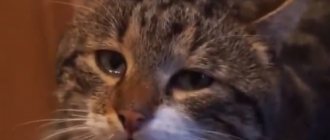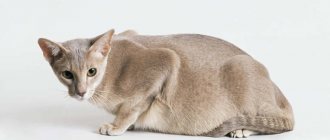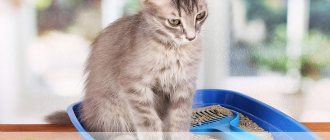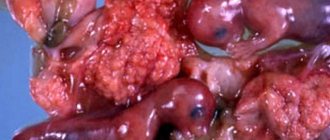For normal functioning of the organs of vision, the anterior surface of the eyeball of mammals must always be well moistened. This task is performed by the lacrimal apparatus. A cat's lacrimal glands constantly secrete a small amount of tear fluid, which has a protective and disinfectant function. The waste moisture goes into the so-called lacrimal lake, which communicates with anatomical structures - lacrimal openings. These are small holes in the corners of the eyes that lead into the tear ducts. Through them, moisture flows into the nasal cavity and evaporates under the influence of breathing.
If the animal is healthy, then there is practically no excess tear fluid. There is no discharge from the cat's eyes at all. A small amount of transparent liquid secretion may be released, which is practically invisible from the outside and does not require elimination.
If the discharge is copious, opaque, has an unpleasant odor and color, it can be assumed that there is an eye pathology. White, green, reddish, brown discharge indicates a bacterial or fungal infection. Let's look at why this happens, let's look at the main causes of pathological discharge from the eyes, find out how to treat the animal, what first aid measures are.
Normal eye discharge
In most cases, cats have slightly wet, shiny eyes. The lacrimal glands secrete secretions to moisturize the mucous membranes. This helps clean the outside, prevents drying out and provides some protection from damage. Cats' eyes do not normally run, but they may release a small amount of fluid when they encounter irritants. Bright light, dust, wind or cigarette smoke can act as a provocateur.
Periodic lacrimation is observed in brachycephalics. In cats with flattened faces, the functioning of the glands and the outflow of fluid are disrupted after a long stay in a horizontal position or on the side. Animals with large bulging eyes are more susceptible to infectious inflammation and external factors, since their organs are less protected by skin folds. The risk group includes Persian and Scottish cats, exotics, bobtails, etc. Representatives of these breeds and mestizos, which have inherited specific traits, require careful care and removal of discharge.
Prevention of eye diseases in cats
Prevention of eye diseases consists of the following actions:
- do not smoke in the room where the pet lives, avoid using perfumes and household chemicals;
- use hypoallergenic ready-made comas of at least premium class;
- destroy ectoparasites and conduct quarterly deworming;
- Vaccinate your pet regularly according to the vaccination plan.
- cats predisposed to eye diseases are periodically instilled with prophylactic agents.
Be sure to read:
The cat does not drink water: reasons, daily intake, what to do, is it dangerous, how to force the animal to drink
Eye diseases or digestive disorders are caused by human food, so giving your pet a treat can result in illness.
The main types of pathological discharge from the eyes
Excessive tearing is not normal, even if the liquid is clear. In case of diseases and injuries in pets, the following main types of pathological discharges can be detected:
- Transparent liquid of normal consistency. A sign of involuntary lacrimation. May occur as a result of injury or in the early stages of disease. Transparent color and liquid consistency indicate the absence of infection. With insufficient hygiene, tears can oxidize and turn into brown crusts, but initially there is no bright shade.
- White mucous discharge. Occurs at the initial stage of inflammation. At this time, it is most often possible to quickly suppress the disease with timely and adequate treatment.
- Greenish or yellow thick discharge. Appear in the last stages of infectious infection. The color indicates the presence of pus. Most often, such discharge is accompanied by general weakness, fever and a state of intoxication. Without help, the animal may lose an eye. Possible death.
- Thick brown or black discharge from your cat's eyes. The hue indicates the presence of red blood cells in the liquid. An increased concentration of red blood cells may be associated with a violation of the anatomical position of the ducts or improper outflow of fluid. Sometimes brown discharge appears in the later stages of infectious diseases if pathogens have penetrated the choroid.
Brown discharge may occur in brachycephalic breeds and breeds with protruding eyes. Conventionally, this sign is sometimes considered normal, but it is advisable to visit a veterinarian for analysis and identification of pathogenic microflora.
DISCHARGE FROM THE EYES IN CATS // Network of Veterinary Clinics BIO-VET
Treating a cat at home.
In order to decide how to treat your pet at home and not cause further damage to it, be sure to first consult with a veterinarian. After the necessary tests and a thorough examination, your cat may be prescribed antibacterial or antiviral treatment, as well as drops, antibiotics or special anti-inflammatory ointments. In some cases, the animal is prescribed physical therapy or surgery.
If your cat has constant excessive tearing and there are scabs in the corners of the eyes, or the cat has swollen eyelids, dark discharge with an unpleasant odor, or blurred vision, then you should take her to a specialist. Pay attention to the pet's body temperature and general condition. Fever, lethargy, depression, sneezing, and refusal to feed are all symptoms of the disease that require detailed study.
You should also contact your veterinarian immediately if your cat has a foreign object in its eye. Under no circumstances try to remove it yourself, as without special tools and the necessary skills you will injure the animal.
You don't have to wait to see a specialist and have a positive impact on your cat's well-being. But keep in mind, the following tips will not cure your pet, but will only temporarily and partially alleviate his suffering until the cat is examined by a veterinarian and the appropriate treatment is prescribed.
Causes
The appearance of dark discharge and brown crusts around a cat's eyes may be due to a violation of the outflow of fluid through the tear ducts or infectious diseases.
Impaired outflow of tear fluid through the nasolacrimal duct (dacryocystitis)
The development of the disease can occur for several reasons:
- Inflammatory processes. Due to diseases of the eyes and neighboring tissues, swelling occurs. This leads to narrowing of the tear ducts and difficulty in fluid circulation.
- Stenosis of lacrimal openings. Narrowing most often occurs as a result of chronic infectious lesions. Stenosis is accompanied by constant lacrimation.
- Blockage by a foreign body. Small debris can get into the ducts and cause inflammation. Later, infection may occur.
- Mechanical injury. If the canals are damaged, black or brown discharge from the eyes of cats is observed. The color is due to the presence of bloody impurities.
- Neoplasms in the lacrimal glands or adjacent tissues. Tumors cause mechanical narrowing of the ducts. With the simultaneous destruction of tissue, blood appears in the secretions. The color turns red or brown.
Infectious inflammation of various areas of the eye structures
There are several forms of infectious lesions of the organs of vision:
- Blepharitis. Inflammation of eyelash bulbs. The owner may think that the cat has dirt in its eyes. Discharge accumulates in the corners. They may be grayish or brown in color.
- Conjunctivitis. Damage to the mucous membrane, which is accompanied by swelling of the eyelids, redness and the appearance of purulent discharge. In later stages, cats are unable to open their eyes due to crusts.
- Keratitis. Corneal damage. Most often, the disease develops due to mechanical trauma and infection. Pathology is accompanied by the formation of a pathological infiltrate. When deep vessels are affected, the discharge becomes dark in color.
- Iridocyclitis. Inflammation of the choroid. Photophobia is observed in animals. Cats may wash or rub their eyes thoroughly due to pain. First, profuse lacrimation occurs, and later a pathological infiltrate is released.
What to do and how to treat?
Before visiting the doctor, you can wipe your pet’s eyes with a herbal decoction.
If the owners notice that the cat’s eyes are festering and other alarming symptoms are recorded, then they should not delay a visit to the veterinarian. At home, it is possible to treat the visual organs with decoctions based on chamomile, calendula and other medicinal herbs that have antimicrobial and antiseptic effects. After conducting a comprehensive examination and identifying the root cause of the problem, the pet is prescribed medications.
You should not apply any eye drops to cats for pus at your own discretion, since there is a high probability of worsening the disease and developing complications. In most cases, it is possible to cope with unpleasant symptoms in a pet with the help of the following ophthalmic medications:
- "Iris";
- "Leopard";
- "Diamond Eyes";
- "Levomycetin".
For a speedy recovery of your pet and elimination of pathological exudate, you need to know how to properly apply eye drops to a cat. To do this, the pet's head is fixed so that the visual organs are directed upward. It is better to perform the manipulation together to ensure reliable fixation of the cat. The pipette must be kept at a distance of 2 centimeters from the eye, so that in case of sudden movement it does not damage the mucous membrane of the eye. Treatment is carried out until the animal recovers completely, until the discharge completely stops appearing.
Treatment of the disease
If you have a question about how to treat your cat, you need to contact the clinic. The doctor will examine and interview the animal owner. Fluid may be collected from the tear glands for testing. This allows you to identify the strain of bacteria and select an effective drug. Depending on the causes of the disease, anti-inflammatory drugs and antibiotics can be used. In advanced cases, surgery is performed. Surgery may involve removing the eye, widening the tear ducts, removing a foreign object, etc.
If visiting a veterinarian is not possible, you can administer first aid to improve the condition yourself. It is recommended to use chamomile decoction for rinsing. It is prepared from pharmaceutical raw materials and distilled water. It is important to use clean liquid, otherwise the eye may become infected.
For rinsing you will need a cotton pad. It is recommended not to use gauze or standard cotton wool, as particles may remain on the surface. Rough fabric can damage delicate mucous membranes. A cotton pad is moistened in the liquid and gently wiped from the inner corner to the outer corner. If there are crusts, do not roughly remove them. You should soak the accumulations, then try to carefully remove them.
Both eyes need to be treated. A separate swab is used for each to prevent transmission of infection. It is allowed to use antibacterial solutions for treatment after permission from a veterinarian.
How to cure a cat
In addition to treating the underlying disease, the symptom of which is increased secretion of the lacrimal glands and a change in their color, attention should be paid to the hygiene of the visual organs. You can remove black discharge from a cat’s eyes using solutions of furatsilin or boric acid. They will not only cleanse dirt, but also provide an antibacterial effect. Solutions can be replaced with strong tea, chamomile infusion or just warm water. In some cases, the cat is prescribed antibacterial drops.
© shutterstock
Prevention
Prevention consists of monitoring and caring for your pet. Most breeds do not require intervention, however, in the case of cats with flattened faces, it is necessary to remove the discharge when it appears. The natural secretion, when dried and oxidized, forms a good environment for the growth of bacteria. This increases the risk of developing diseases.
Eye diseases in kittens! Herpes of the eye and calicivirus in cats.
To prevent discharge, it is recommended not to give your cat sweets. Animals metabolize sugar worse than humans. Some of the breakdown products enter the bloodstream and cause a reaction from the immune system. This causes discharge from the eyes, itching and redness of the skin.
All information posted on the site is provided in accordance with the User Agreement and is not a direct instruction to action. We strongly recommend that before using any product, you must obtain a face-to-face consultation at an accredited veterinary clinic.
How to wash a cat's eyes at home?
Suitable herbal infusions of chamomile, oak bark, and saline solution will help your cat cope with the disease before being examined by a doctor. You can also wash her eyes with an alcohol-free antiseptic solution.
You need to wash your cat's eyes with a cotton swab, from the outer edge to the inner. This must be done very carefully and gently so as not to harm the pet and cause him a minimum of discomfort.
Discharge from the eyes and nose is also treated with special ointments. In some cases, the cat needs to pull back the lower eyelid and put ointment there, for example, tetracycline ointment, novocaine, hydrocartisone drops, levomecitin drops. Keep in mind that it is not recommended to use antibiotics and ointments on your own without a veterinarian's prescription.
Why is the kitten crying?
It is natural for a kitten to shed tears when its eyes open and adapt to the bright light. But their number is small, and the mother cat often licks the kittens and the owners rarely notice it. Babies need to be examined carefully. Excessive lacrimation may also indicate helminth infection. Kittens up to 2 months old can receive anthelmintic therapy only after examination and as prescribed by a veterinarian, who will calculate the dosage of the drug.
Tears in a kitten separated from a cat early may indicate a weakened immune system. If he has difficulty opening his eyes, wipe them with a damp cotton swab and contact your veterinarian. He will give nutritional advice and prescribe a vitamin complex to strengthen the immune system.
Why do Scottish Fold cats have watery eyes?
global $ads_google; //data-ad-slot=”2475549904″ $ads_google = empty($ads_google) ? false : true; ?> if ($ads_google == false) {?> $ads_google = true; ?> } ?>
Breeders and cat lovers know that Scottish kittens and adult pets often have watery eyes. In childhood, this symptom is more pronounced than in adulthood. The anatomical structure of the head and eyes of these cats has special differences. The canal coming from the lacrimal gland is shortened, so tears do not linger in the ducts and quickly come out. The predisposition is explained by the flattened shape of the skull, which determines the non-standard structure of the ocular analyzer.
Scots' eyeballs are large, so they require regular washing with tear fluid. Otherwise, the cat is at risk of drying out the cornea. At the same time, cats that show suspicious signs must be examined, since eye diseases are no less common in them than in other breeds.
How to treat the eyes of small kittens
In the first months of life, baby animals are not able to care for themselves independently. Inflammation of the kitten's eye mucosa often occurs with the release of brown secretion.
The pathology also manifests itself in blind kittens. They undergo regular eye rinsing (up to 6 times daily) until the age of three months.
To clean, take a cotton swab soaked in antiseptic. The kitten's eyelids are carefully separated (if the eyes have already opened) and the procedure is carried out.
Washing is done in the same way as for adult animals. It is important to consult with a specialist about the need to prescribe antibiotic therapy.
Establishing diagnosis
Before starting treatment, it is imperative to conduct a diagnosis that will help identify the true cause of excessive lacrimation and carry out effective treatment therapy. Only a veterinarian can conduct a correct and thorough examination.
Important! Before going to the veterinarian, be sure to prepare a pet card, which should indicate all vaccinations, anthelmintic treatments, and past illnesses. It is advisable to write down symptoms of malaise and other suspicious signs on a piece of paper.
Sometimes the veterinarian may be interested in the following important questions at the appointment:
- how long the symptoms last;
- how did the first symptoms of tearing from the eyes appear and the peculiarities of the course of this condition, for example, did two eyes immediately begin to water at the same time, or vice versa, first one began, and then the other, and whether there are other additional symptoms;
- when the last procedures to eliminate helminths, fleas, ticks and other parasites were carried out.
To make an accurate diagnosis, the veterinarian will definitely take a urine and stool test. It is advisable to already have the research material with you before going to the doctor. Also, at the appointment, he will definitely take mucus from the eye for examination; for this reason, there is no need to first rinse the pet’s eyes with various solutions.
Diagnostics
First, the doctor examines the animal for injuries, collects information about its state of health, and finds out what chronic diseases it has. Next, to make a diagnosis, the veterinarian needs to conduct a number of diagnostic tests, including studying the frequency and consistency of discharge.
In some cases, it is necessary to conduct an ultrasound examination of the affected eye and x-ray of the skull.










